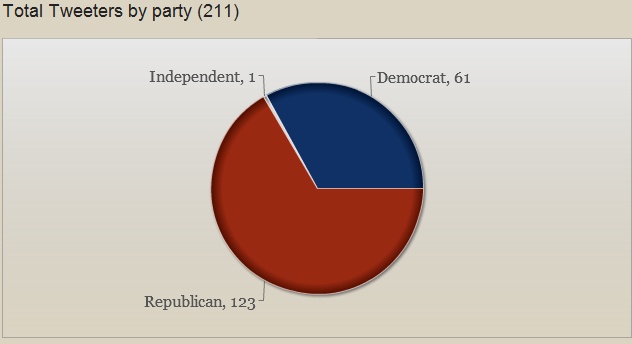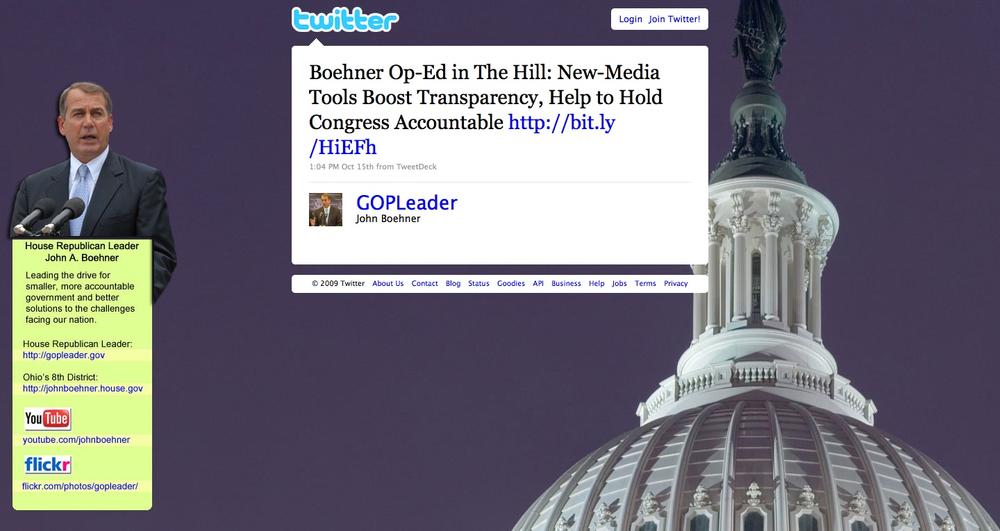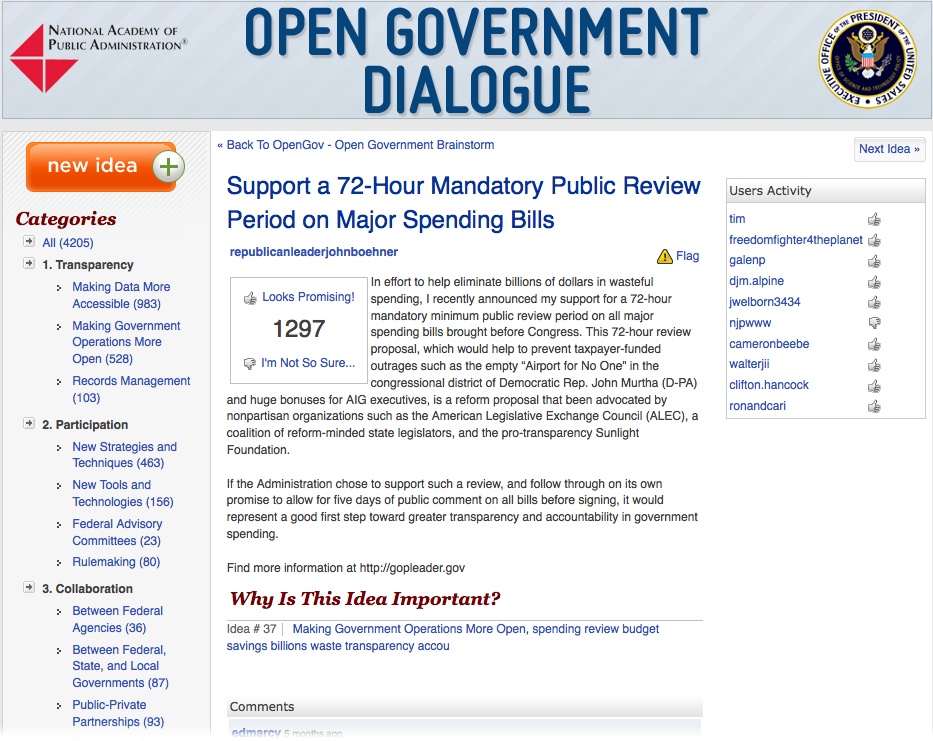Chapter 16. Entrepreneurial Insurgency: Republicans Connect With the American People
When it comes to politics and government on the Internet, it’s the Democrats’ Web—the GOP just browses it, right? From Howard Dean’s campaign pioneering online fundraising to candidate-then-President Obama’s team’s top-to-bottom integration of the Web, the conventional thinking is that the left has lapped Republicans in the race to digital dominance. As many of you reading this may know, this perception is hardly the true picture, particularly in Congress. In fact, when I go into work every day, I see a very different story unfolding.
Significantly outnumbered and looking for new, more efficient ways to engage the American public, the current minority party in Congress has moved aggressively into the social media space to not only promote their message but also shine more light on the workings of the majority’s activities. This creative use of the Web to circumvent traditional channels and deliver a clear, unfiltered message to the American people is the hallmark of what has been dubbed entrepreneurial insurgency.
Entrepreneurial Insurgency and Congress
The term itself was coined by Republican Policy Committee Chairman Rep. Thaddeus McCotter of Michigan at an elected leadership retreat in January 2009. A major theme of that retreat was how to communicate more effectively using emerging and established social media tools. While there, members of Congress and staff members exchanged ideas and previous experiences in using the Web on their campaigns or in an official capacity. As we spoke, we found that nearly everyone had some personal experience in social media (many of us were surprised to find that my boss, John Boehner, had been quietly maintaining his own personal Facebook page), and everyone had unique stories of how it had helped them connect with family, friends, and constituents.
While this certainly wasn’t the first time House Republicans discussed putting more focus on the Web, I believe this was a turning point in how the new media piece fits into the larger messaging puzzle. It was about this time when it was decided that our digital outreach was going to be a consideration in every major effort that we would undertake. Far from an afterthought or simply the domain of the “tech guys,” an aggressive engagement online was not only going to help us tell the story, sometimes it would be the story itself.
It was also about this time that we began to see some very interesting things happening in terms of who was using social media in Congress. This chapter discusses Twitter and YouTube in Congress and how they fit into the larger push for increased transparency in government. That’s not to say that these are the only tools being used. Thankfully, due to some recent rule changes (more on that in a bit), it is now permissible for representatives to publish official content nearly anywhere on the Web, providing that the content itself conforms to established regulations prohibiting fundraising, overtly political language, and other nonofficial activities. Members have taken full advantage of this opportunity and have been experimenting with everything from mobile streaming video to SMS text with great success.
Congress Tweets, Too
So, some of you may have heard of Twitter. I say that with more than a little tongue-in-cheek sarcasm, as you’d be hard-pressed to turn on your television or computer or walk down the street without hearing multiple pleas from news anchors, celebrities, musicians, and your friends and neighbors to “follow” them on the trendy microblogging service. For a technology that in many ways subverts the traditional media, the media has an undeniable love affair with Twitter, twitterers, and tweets. Oprah is on Twitter, my dad joined Twitter, and…the U.S. House cafeteria is on Twitter? If you’re anything like me (and by me I mean @nickschaper), you may be suffering from occasional bouts of Twitter-publicity fatigue.
Not to worry, I won’t be bothering you with yet another description of Twitter. What I do want to explore is a phenomenon that has gone largely unnoticed to those outside the beltway new media world: far more Republican members of Congress are using Twitter than Democrats. Not exactly an earth-shaking revelation in and of itself, but the fact remains that one of the newer, shinier tools in the new media shed is solidly the domain of the GOP in Congress. Figure 16-1, from TweetCongress.org, depicts the number of Republican and Democrat users in the U.S. House and Senate. As you can see, Republicans outnumber Democrats on Twitter by more than 2 to 1. (For more on Tweet Congress, see Chapter 15.)
The minority has taken to Twitter because it exemplifies the entrepreneurial insurgent mindset. As a simple tool that has the power to not only reach thousands, but also receive their feedback and quickly judge public sentiment, Twitter is a powerful device. Using Tweetreach.com I recently observed the spread of a tweet sent from Leader Boehner (@gopleader); see Figure 16-2. The tweet itself was simply highlighting a Politico article noting the party disparity on Twitter I’ve described. In less than a matter of minutes, Tweetreach estimated more than 60,000 impressions of the link we transmitted to our modest list of 7,000 or so followers. Not too bad for fewer than 140 keystrokes.
“So what?” many will say. So Republicans figured out how to use Twitter, big deal. They’ve got only a few thousand followers anyway, and are they even tweeting themselves? Because as so many in the twittering class will tell you, if a politician isn’t sending his own tweets, reviewing all his replies, following all his followers, and keeping up with #musicmondays and #followfridays, then he’s not doing it right, right? #wrong.[163] Like people all over the world, members on both sides of the aisle are using Twitter in ways that reflect their styles. Some are intensely personal, others just like to share links to what they’re reading, and still others have their RSS feeds running the entire operation on autopilot. I reject the notion that there is a right way to use Twitter and other popular social media tools. Certainly, some are more effective than others, and we all surely have much left to learn. But the fact that an institution known best for 200 years of tradition is finding new ways to connect with the electorate should be encouraging to all of us.
So, maybe Twitter is the exception—the talk radio of the new media landscape. By many expert accounts, it might not even be with us in a year or two (as an aside, I’m certain that most who smugly note the company’s huge user base and lack of plan to monetize would be quite happy to have such problems). But what if Twitter isn’t the only example?
I YouTube, You YouTube
For years now, members of Congress have been posting hours of video to their websites and eventually their YouTube channels. As technology has made video recording and editing more accessible to staff members, multimedia content from floor speeches to news appearances to video podcasts are thankfully now a fixture of most congressional websites. As a free, easily accessible, wildly popular public forum, YouTube was almost immediately a hit in the halls of Congress. That’s not to say there weren’t some bureaucratic hurdles to overcome before Congress was officially allowed to get their YouTube on. Some of these obstacles may not have been overcome if it weren’t for the help of activists around the country.
In July 2008, Congress decided it was time to amend the antiquated regulations that guided members’ official communications. As new Internet usage rules were being considered in the House Administration Committee, a leading member of the committee drafted a proposal that had the potential to prohibit nearly everything discussed in this chapter, including YouTube, Twitter, and Facebook. Asked by the Speaker of the House to recommend how best to proceed, Rep. Michael Capuano (D-Mass.) proposed the creation of an “acceptable” list of websites that would be developed and maintained by members of the committee and their staff. Faced with the prospect of bureaucrats picking winners and losers—while almost certainly stifling innovation by drastically slowing the institution’s ability to react to evolving technology—concerned citizens of all political persuasions spoke out on the need for each member to decide for himself how to best communicate with his constituents. Eventually, the committee adopted a decidedly more open policy based on recommendations drafted by committee Republicans (http://www.theopenhouseproject.com/2008/10/03/franking-reform-a-happy-ending/).
With the change in rules and the bipartisan launch of the YouTube House and Senate Hubs, designed specifically as a destination for constituents looking for their elected officials’ videos, members are free to chronicle every minute of their day on Capitol Hill (and many do). As more time passes, though, we are beginning to see some very intriguing original content emerge. Members and their staff began to understand that video sharing communities such as YouTube are more than just a depository for floor proceedings and press conferences. Some of the most senior members of the House and Senate brought handheld cameras into their offices and introduced the staff to their constituents and others around the Web by simply pressing the Record button and being themselves. Realizing that social networks are meant to be a discussion, not a speech, representatives put the call out asking their constituents how they could better serve them, or to help by offering their insight on the issues before them in Congress.
Gathering Effective Tools
Like Twitter, the minority party has come to know YouTube as one of the most effective weapons of the entrepreneurial insurgency. When the content is compelling (and that is no small caveat), YouTube—along with Twitter, Facebook, and others—ensures that many thousands of eyes will see it in minutes. When Rep. Dave Camp, R-Mich., pressed a Democratic witness on job creation in the proposed stimulus package, the video was seen nearly 100,000 times in a matter of hours. When Republican Whip Eric Cantor asked Americans via YouTube to submit their questions and ideas about how to get the economy going again, the video saw more than 150,000 views and dozens of responses. When Leader Boehner, furious at having not been allowed to read the 1,200-page stimulus package, threw the bill onto the House floor, the 36-second video spread like wildfire. As I write this, that short video of Boehner has been viewed nearly half a million times.
Encouraged by their success, Republicans have moved quickly to take advantage of advances in low-cost video production software and camera equipment. Creating a for-web video composed of unique content directed at the online community is now a common component of our messaging strategy that has helped to break through some of the noise and deliver a clear message.
In a May 2009 analysis by web video industry watcher TubeMogul Inc., it was shown that congressional Republicans’ YouTube channels had nearly 2 million more views than their colleagues in the majority. And while Republicans had uploaded fewer overall videos, their average view count was more than double that of their counterparts (1,572 to 750). That same report found that eight of the top 10 congressional channels on YouTube belonged to Republican members.
Social Media and the Fight for Transparency
Social media is helping to bolster another crucial movement that has found many strong advocates in the minority party. Transparency initiatives led by citizens, advocacy organizations, and elected officials themselves have benefited dramatically from the widespread adoption of sites such as Twitter, YouTube, and Facebook. It has never been easier to find out who your elected officials are, what they’re doing, and how you can contact them. Aside from tracking elected officials themselves, we are beginning to see more and more public information made available online in an easily usable format. Beginning as an oft-repeated campaign promise, the Obama administration has devoted significant resources to the development of websites such as Data.gov and Recovery.gov with a stated goal of providing complete transparency in how federal money and resources are being allocated. By all accounts, the jury is still out on the effectiveness of these sites, particularly Recovery.gov. Recovery.gov, already in its second redesign and carrying a staggering price tag approaching $18 million, has come under increasing scrutiny lately for not performing some of its basic promised functionality.
One interesting example of this intersection of social media and transparency was observed during the initial stages of the White House’s Open Government Initiative. Seeing a unique opportunity to start a discussion on transparency in government spending with the president and the American people, Leader Boehner and our office submitted an idea to a public online forum created by the White House. The Boehner-submitted idea (see Figure 16-3), a 72-hour mandatory minimum public review proposal on spending legislation, was already backed by a wide range of outside groups including Sunlight Foundation and the nonpartisan American Legislative Exchange Council (ALEC), a coalition of reform-minded state legislators. Leader Boehner’s submission also asked that President Obama make good on his promise to provide for five days of public comment on all legislation before being signed into law. (According to the Cato Institute, since taking office President Obama is one for 39 in providing that review period.)
In announcing the Open Government Initiative, the administration welcomed any and all ideas on increasing openness and transparency, saying:
We are seeking innovative approaches to policy, specific project suggestions, government-wide or agency-specific instructions, and any relevant examples and stories relating to law, policy, technology, culture, or practice.
This seemed to be an ideal forum for the 72-hour/five-day reviews, especially considering the established support of the public, and the president himself. Thousands of Americans agreed, and at the conclusion of the scheduled voting period, the idea received more votes than any other. So, surely the White House took the idea into consideration, right? Not so much. When ideas from the “brainstorm” phase were chosen to move forward for further development, it was apparent that administration officials handpicked them with no regard for public support or merit. In the White House blog post “Wrap-Up of the Open Government Brainstorming: Transparency”, White House Deputy CTO Beth Noveck indicates that the process may not be nearly as broad in scope as had been previously stated:
We took the voting into account when assessing your enthusiasm for a submission, but only somewhat in evaluating relevance…. There were plenty of great ideas that we read but that unfortunately did not make sense to bring into the next phase, including those…outside the purview of the Executive branch.
So, to the nearly 1,200 supporters of Leader Boehner’s submission, the thousands of supporters of Sunlight Foundation’s Read the Bill initiative, American taxpayers seeking more accountability in government spending, and yes, even the president, who has been a vocal supporter of the concept in the past, administration officials had a message: it didn’t “make sense” to discuss this idea any further.
That attempt at eliciting citizen opinions illustrates an internal struggle that I see happening in offices and agencies all over Washington. In the quest to increase participation and openness, what do you do when inconvenient ideas and comments are submitted (e.g., marijuana legalization)? What do you do if they highlight some of your shortcomings? This is still one of the most formidable barriers to entry into social media for elected officials. Worried about unflattering comments slipping by, many representatives highly censor or turn off the comments on their YouTube and Facebook pages. Others, as we observed earlier, simply choose not to bother at all. As time passes and we come to expect more interaction from our representatives, I have a feeling that fewer of those who decide to stifle that communication will be in Washington to regret it.
I would be remiss to not acknowledge how much easier it is for the minority party to call for increased transparency, without the direct ability to effect change. I have been told many times that when Republicans regain the majority, expectations will have been set very high. Some have asked whether we will be able to produce the degree of openness we have demanded from our colleagues across the aisle. I’m happy to report that aided by the entrepreneurial insurgent tactics I’ve discussed, Republicans are making sure those questions will be answered in the next two to three years.
I’m not saying that Republicans will win back the majority because of their enthusiasm for social media and aggressive promotion of transparency. But I am certain that this is important. These numbers show that the Right is willing to step outside its comfort zone to engage new constituencies and continue to fire up established ones. For a sign of how times have changed, look no further than Senator John McCain, who was excoriated for his lack of a mobile device and for not being computer savvy, but now sits atop the Twitter heap in Congress with close to 1.5 million followers.
And while the Right is leaping out of its box, the Left seems quite content in it. And why shouldn’t they be? Our first wired commander in chief and the First BlackBerry have more than enough innovation to go around. That seems to be the hope of Democrats in Congress. For instance: to date, not one member of House Democratic leadership feels that Twitter will add anything to his messaging.
Note
It is worth noting that House Speaker Nancy Pelosi did announce her entrance into tweeting in US News & World Report. She quickly racked up about 500 followers (including yours truly), but has yet to send one tweet. So, it’s at least safe to say that Pelosi is aware of Twitter.
Conclusion
Despite the political party, the importance of understanding the power of social media tools—regardless of which one is the most popular at the time—far exceeds the usefulness of each individual device. If we have learned anything over the past 10 years it is that digital media is advancing faster than any one brand (with perhaps one small exception) can anticipate. Technology will continue to evolve, and when it does politicians who cut their teeth on Twitter and Facebook won’t miss a beat when the next opportunity to connect with voters and constituents hits the scene.
I don’t claim to be unbiased in my appraisal of these recent trends. But it is hard to ignore the success in which a far-outnumbered party has been able to mount a number of very successful offensives. But my feelings won’t be hurt if you completely discount everything I’ve observed here. In fact, especially to my friends on the other side of the aisle, I wouldn’t worry much about any of this. Nothing to see here.
About the Author
Nick Schaper currently serves as director of new media for House Republican Leader John Boehner (R-OH). As a part of one of the most active and innovative communications teams on Capitol Hill, Nick focuses on developing new ways to expand Boehner’s messaging online while assisting other members of the GOP Conference and their staff in executing effective, forward-thinking media strategies. Under Boehner’s direction, Nick and his colleagues have orchestrated House Republicans’ aggressive use of digital and social media in promoting GOP solutions. Nick previously served as director of congressional affairs for Adfero Group, where he helped more than 100 members and candidates harness the power of contemporary new media tools.
Get Open Government now with the O’Reilly learning platform.
O’Reilly members experience books, live events, courses curated by job role, and more from O’Reilly and nearly 200 top publishers.





